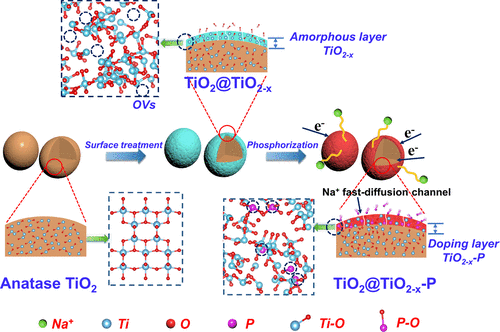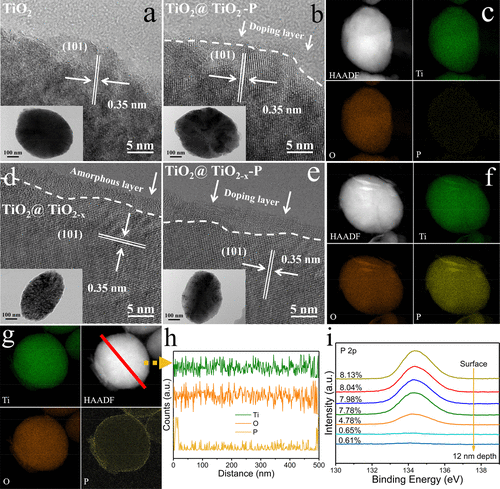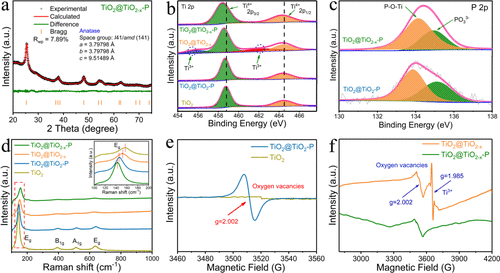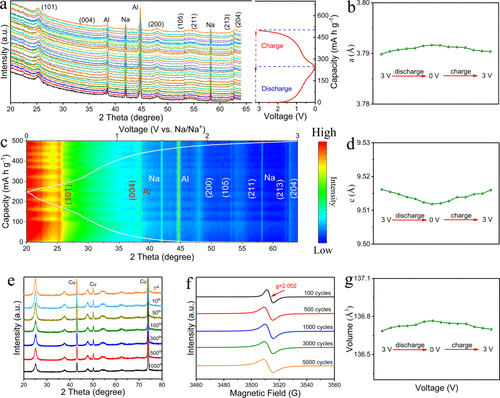Rechargeable sodium ion batteries (SIBs) are competitive alternatives to lithium ion batteries as stationary energy storage systems because they are considered benign, relatively cheap to manufacture, and sodium is an abundant resource. However, finding suitable anodes for effective and reversible accommodation of large Na ions has become a source of significant research focus, with many considering titanium dioxide (TiO2) as the current standard. While it has a high theoretical capacity, nearly zero strain on sodiation and desodiation (the replacement of metal ions with sodium and vice versa), and there is plenty of it, it offers a very low rate capability and poor electrical conductivity.
Recently, Prof. Lu Zhouguang from the Department of Materials Science and Engineering (MSE) at Southern University of Science and Technology (SUSTech) led his research team to propose a new strategy to improve the rate capability of TiO2 anode material for SIBs by defect-induced selective surface doping. The results were published in ACS Nano, a leading nanomaterials journal, with the paper titled, “Defect-Assisted Selective Surface Phosphorus Doping to Enhance Rate Capability of Titanium Dioxide for Sodium Ion Batteries.”

It had been well-established by previous research that phosphorus (P) doping could effectively improve the electrical conductivity of TiO2. However, traditional phosphating strategies provide a low doping efficiency, offering less than 2 at% due to the relatively stable crystalline structure of TiO2, limiting the diffusion and mitigation of heteroatoms (in this case, P). Meanwhile, too high concentration of heteroatom doping can destroy the crystalline structure of the material, seriously affecting its cyclic stability. Thus, the preparation of TiO2 with high doping concentration and good crystalline structure is very challenging.

The research team focused on the existence of oxygen vacancies and trivalent titanium defects, as they were known to improve the electrical conductivity of TiO2 while also improving the diffusion and mobility of various heteroatoms. They theorized that the selective doping of the surface of TiO2 would allow for a significant improvement in the electrochemical performance of TiO2 electrode in SIBs.
They developed a defect-induced P selective doping strategy on the surface of TiO2. Through the reduction reaction with sodium borohydride, an amorphous layer rich with oxygen vacancies and trivalent titanium defects was introduced on the surface of titanium dioxide. Without sacrificing the crystallinity of TiO2, the amorphous layer was selectively doped with high concentration P on the surface of TiO2 nanoparticles, and a uniform amorphous TiO2-x-P layer was constructed.

The results of this experimentation showed that their methods would allow for the phosphorous ions to react with the TiO2 particles, thereby creating P-O bonds with excellent structural stability, enhanced electrical conductivity, and a fast diffusion path for sodium ions. They also found that the higher P-doped samples performed better in all measures than the non-doped samples, including voltage profiles, cyclic performance, rate capability, and high-energy stress testing.

They concluded that a simple defect-assisted selective phosphorus doping strategy has been successfully established to modify the surface structure and achieve a high P doping concentration for anatase TiO2 nanoparticles. This defect-assisted selective P doping approach could definitely be extended to different heteroatoms (e.g., N, S, and B) doping in various nanomaterials.
This work was mainly completed by Prof. Lu Zhouguang’s team doctoral student Gan Qingmeng, who is completing his Ph.D. under a joint SUSTech-NUS program. Prof. Lu Zhouguang is the communications author, and SUSTech is the communications unit.
This project has been awarded by Shenzhen Science and Technology Innovation Commission’s Department of Basic Research, National Natural Science Foundation of China, Guangdong Provincial Key Laboratory of Electric Power Energy Materials and Guangdong Pearl River Innovation Team Project. This work was also supported by the President’s fund, Supercomputer Center of SUSTech and Dr. Qiu Yang from Materials Characterization and Preparation Center.
Links to papers:
Proofread ByXia Yingying
Photo ByDepartment of Materials Science and Engineering